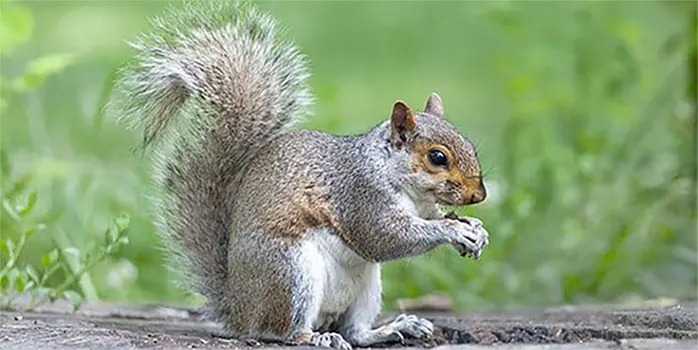
How To Get Rid Of Squirrels
March 21, 2024
Squirrels are typically discovered because they make a lot of noise in the area they inhabit. If you have heard these pesky little creatures running around your attic, continue reading to discover the best ways to identify, prevent, and get rid of squirrels. We make squirrel removal simple!
These pests can cause damage to your home by gnawing on the exterior and interior walls, timbers, cables, and electric wiring. They have been known to short out electric power transformers due to their activities around power lines.
There are several squirrel species, but tree squirrels are the most common nuisance for homeowners because they inhabit attics and garages and cause damage. Eastern gray squirrels are the most common structure-infesting squirrel species.
Squirrels are abundant in the wild because their numbers far exceed the number of predators. The large population and decreasing natural habitat due to construction in many areas cause them to seek shelter in houses. The chilly months of fall and winter cause squirrels to seek warmth in attics.
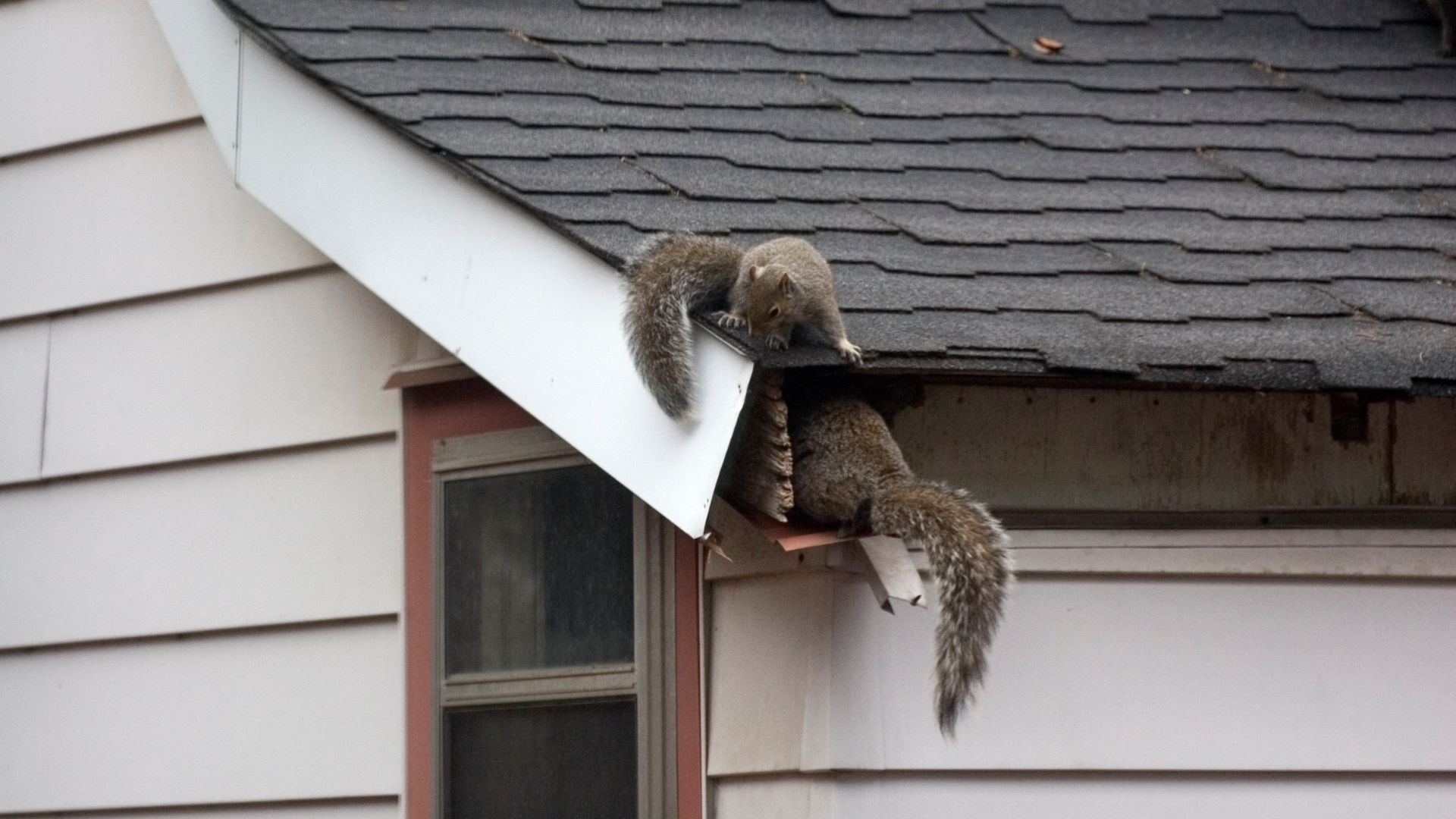
Get Rid of Squirrels
1. Use Gutter Guards
Using gutter guards and covering downspouts will reduce the number of squirrels entering through the rooftop and facia boards. Gutter guards are an excellent starting point for squirrel removal.
2. Use Poison Baits to get Rid of Squirrels
When looking at squirrel control, there are limited poison baits on the market that will get rid of squirrels once and for all.
The one exception is Ditrac Ground Squirrel Bait is only made to control the California Ground Squirrel (found in western states). Typical rodent control bait for mice and rat control will not work against other squirrels.
3. Trap Squirrels
When you have a squirrel infestation in your home, the live trapping method is the only way to get rid of squirrels. Catching a squirrel is the only way to get rid of them in your attic once they have chewed holes.
It is important to seal up and repair all entry points after trapping the squirrels, so they no longer have access. Squirrel traps make squirrel removal more humane, and are straightforward to operate.
Tips for Trapping Squirrels
-
Place the squirrel trap along the path of entry and places of known foraging activity.
-
Go about 4-5 miles away to relocate the squirrels, or they will find their way back to your area.
-
You may want to consider local ordinances for trapping squirrels, which differ. Sometimes, a professional trapper with a nuisance control license is needed to capture the squirrel and relocate it.
Key Takeaway
Live trapping, while labor-intensive, is the only reliable method for removing squirrels once they are in the attic.
The Best Squirrel Traps
-
Safeguard #50450 Single Squirrel Trap
This squirrel trap can be used on all squirrel types: red squirrels, flying squirrels, and larger gray squirrels. It also traps rats well.
It traps ground squirrels (red and flying), rats, weasels, chipmunks, and similar-sized animals. Single door rigid live trap. Automatic locking doors to provide an almost escape-proof catch every time.
-
Measures 18"x5 x5" with 1/2" grid.
-
Made in the USA.
-
The closing mechanism is one of the best on the market.
-
-
Use this trap for the larger Gray squirrel types, but not the smaller squirrel types.
The 1-inch grid would make this trap less preferable for trapping rats or smaller squirrels.
-
Single Door Spring Loaded
-
17" x 7" x 7" has a 1" grid.
-
Trapping Gray Squirrels
Use 1-inch or 1/2 Grid Squirrel Traps to get rid of Gray Squirrels
To trap gray squirrels, place their traps along their pathways or entry points. Place live traps along the roof, at the base of a tree, or at the base of the building they are entering.
Trapping Flying Squirrels
Use 1/2 Grid Squirrel Traps to get rid of Flying Squirrels.
These pests must be trapped inside the attic areas because they glide into the attic. Look for their areas of activity, such as droppings, when placing the traps. Also, look into insulated areas that they use for nesting to place traps.
Extra Squirrel Trapping Tips
-
Always use work gloves when handling the traps with a squirrel inside.
-
Some trappers like to use a technique called "pre-baiting" to gain the squirrel's confidence. Leave the trap out, wired open (so it won't shut) with the bait so that they can get used to the object in their environment. However, most of the time, this technique is not needed to trap squirrels successfully.
-
Place the traps where you hear or see the activity. Using a Rat/Squirrel lure(walnut/nut oil-based) on a cracker or piece of fruit behind the trip pan is very helpful as a lure. You may also try peanut butter. Next, use sunflower seeds on top of that and trail a line of sunflower seeds out the trap's front door so that there are "free" seeds a couple of feet in front of the trap. This method will help overcome any anxiety the squirrels may have about entering the trap.
Squirrel Identification
To learn how to get rid of Squirrels in your yard, you must be able to clearly identify which species you are dealing with. Identification is the first step in squirrel removal.
When inspecting your property for squirrels, the different species you will come across include:
-
Flying Squirrels
-
Gray Squirrels
-
Red Squirrels
-
Thirteen-Lined Ground Squirrels (Striped gophers)
Flying Squirrels
The typical habitat for the Flying Squirrel is inside tree cavities in hardwoods. Smaller than the gray squirrel, they enter the tiniest of cracks and holes. The flying squirrels are about 9 inches long, including a 3-4 inch tail, and weigh about 3 ounces as an adult. They have dense, soft brown fur, and a white belly.
The flying squirrels don't fly but glide into attics from trees. They glide using a thin skin that extends out from the sides of the body and connects the front and hind legs, as shown in the above picture.
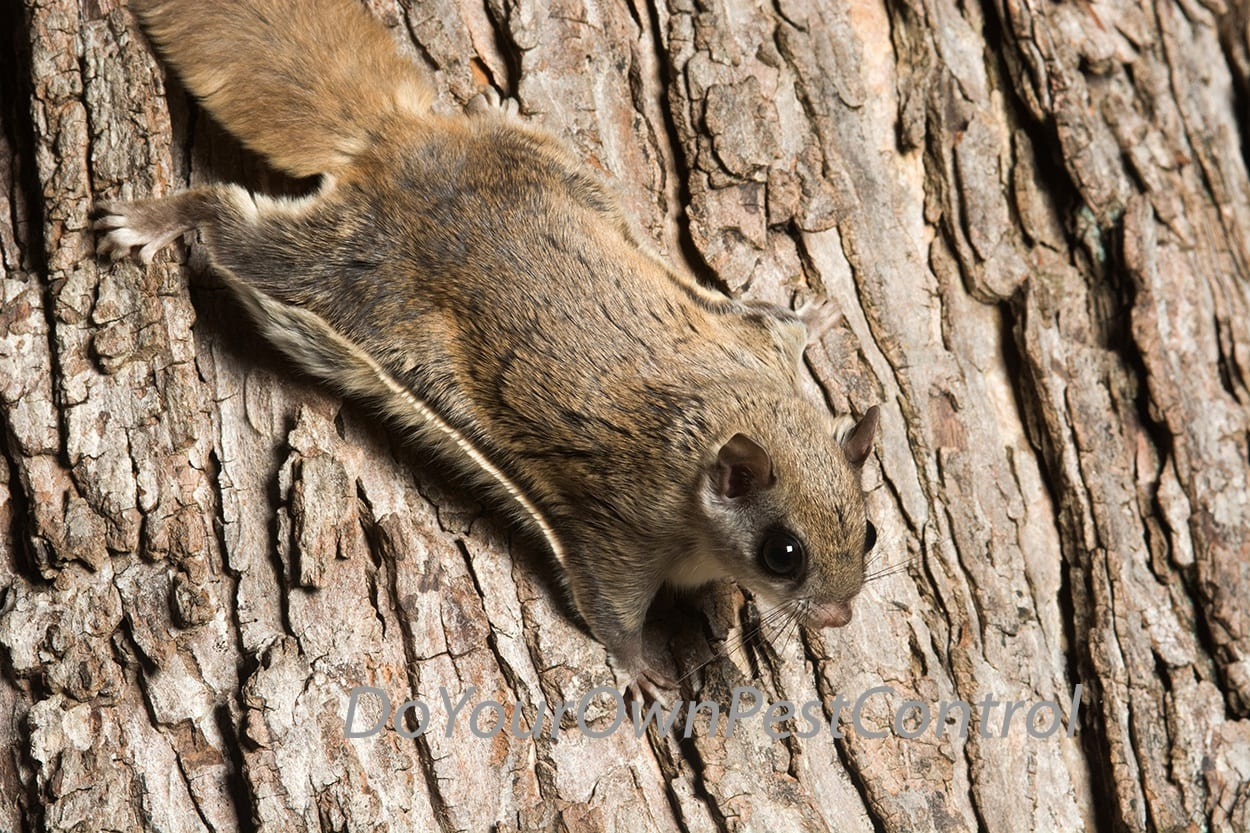
In "flying," the squirrels leap spread-eagled and use their outstretched gliding membranes for gliding and their bushy tails for guidance. Glides of 60 meters (almost 200 feet) or more have been recorded of the Flying Squirrels.
Flying squirrels are nocturnal, with their major activity at night. They are known to make plenty of noise during the night. Can be commonly heard, making a great deal of noise at night between sunset and sunrise. They may be heard landing on the roof or the sides of the house.
How Flying Squirrels Enter Buildings
Flying Squirrels can enter the attics through the eaves and soffits through small cracks. These squirrels may quickly enter the space between the rooftop and facia board, chewing the area for a wider entry point.
Gray Squirrels
Gray Squirrels are about 18 inches long, including their 9-inch tails. They are larger than flying squirrels. Gray Squirrels weigh about 1-1.5 lbs. as an adult. Their coloration is usually gray or salt and pepper, but they can have tan hairs in their fur as well as white bellies.
The winter coat is gray above with a white underside; the summer coat is shorter, sleeker, and brownish gray above.
Red squirrels have red/brown upper parts in summer but may show some gray on the back in winter, leading to some confusion. Red squirrels are smaller, and lighter, have ear tufts, have a prominent winter coat, and are brown on the legs and tail.
Natural habitats for Gray Squirrels are wooded areas in tree cavities. They can be found near hardwoods like oaks and hickory trees. These squirrels will construct feeding shelters out of leaves.
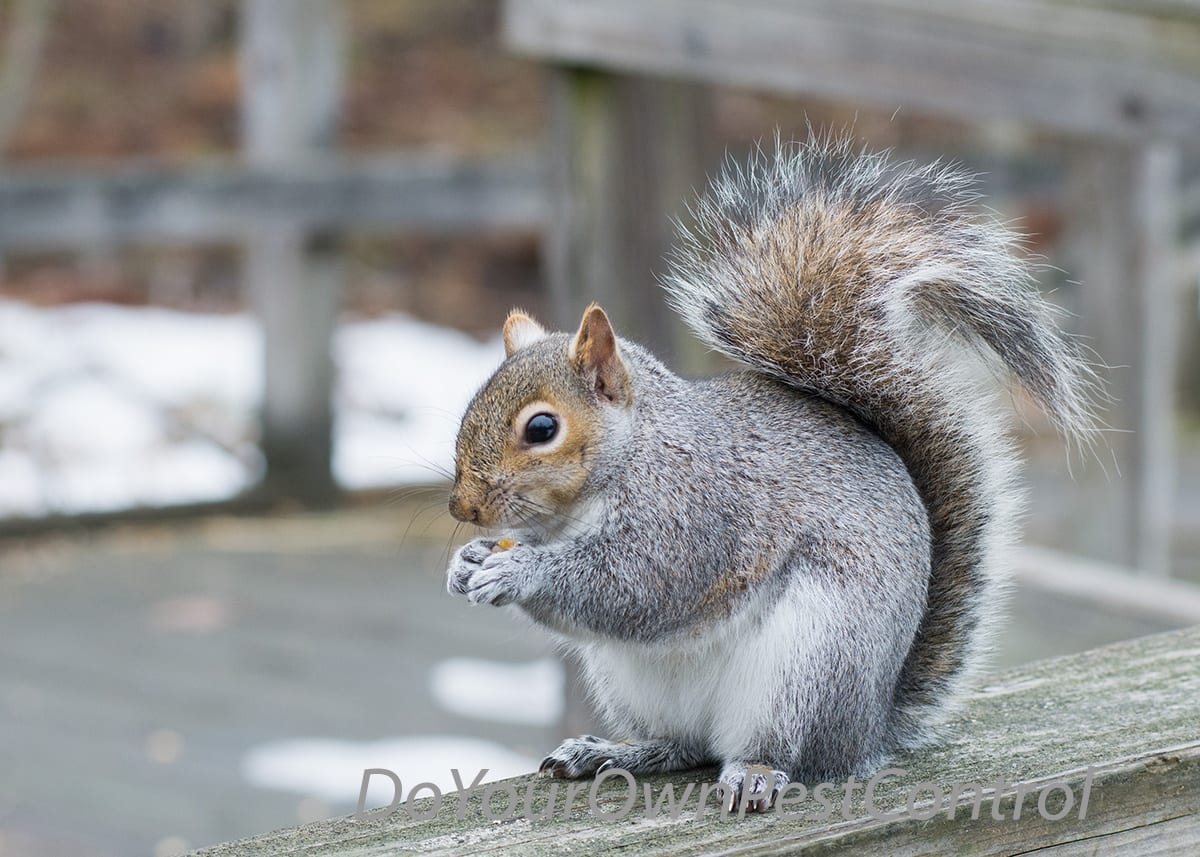
More Gray Squirrel Features
-
Generally have two litters a year, 2-4 young per litter. They usually breed in midwinter and late spring. Gestation is about 44 days.
-
Their diet consists of bird eggs, insects, berries, fruit, vegetables, nuts, and nestling birds. They like to hoard their food.
-
Gray squirrels are active during the day, expecting to hear them during the daytime.
-
Can inhabit the attic areas as well as crawl spaces. They like to enter the attic areas from your gutters and nearby trees and bushes.
-
Installing gutter guards or downspouts with the screen may prevent them from climbing up to the roof through a downspout. Continue reading if you want to get rid of squirrels in your attic.
Red Squirrels
The American red squirrel is smaller than the flying or gray squirrel. It has a deep red color with a whitish underbelly and a distinctive white ring around its eyes. Their tails are not as bushy as other tree squirrels, and their color varies from red-brown to yellow-gray.
They measure about 6 inches with a tail length of about 3-6 inches. Sometimes Red squirrels and Gray squirrels can look similar, even with their color variations. Red squirrels have ear tufts, while gray squirrels do not have ear tufts.

The Red squirrel has a notable screech, chirp, or growl; they are very vocal. These squirrels range across the USA and Canada, from the Rocky to the Appalachian Mountains and from Arizona to Georgia.
They are active during the day and feed on nuts, seeds, conifer cones, fruits, bird eggs, and nestling birds. They will defend their territories more so than other squirrels. They do not hibernate but will seek shelter during adverse weather conditions.
Just before winter, they hoard food in nests, burrows, and tree cavities. They mate during the spring months and fall months.
Thirteen-Lined Ground Squirrels (Striped gophers)
The thirteen-lined squirrel is another common pest found around lawns and foundations. They prefer grassy areas and hibernate during the winter months. They can damage newly planted seeds and pull up wheat, oats, and barley.
They eat mice and insects. They make burrows but are poor climbers. They are commonly distributed in the midwest, from northern Texas to parts of Canada.
There are many other species of squirrels, such as fox squirrels, but the four listed above are some of the most common types you may come across.
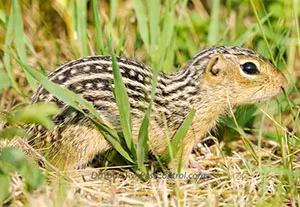
How to Prevent Squirrel Entry to Buildings
-
Trim tree branches that may overhang the roofline to prevent squirrels.
-
Remove firewood stacked against the building.
-
If there are cracks in the foundational wall, repair them.
-
Seal entry points to prevent squirrels from sneaking indoors.
Prevent Squirrels: Exclusion and Relocation
After trapping and relocating any squirrels inside your home, you can seal the openings with 1/4" mesh hardware cloth or metal flashing. Look for all possible entry points.
If you are not handy with tools, many nuisance wildlife control companies will help you prevent squirrels by sealing entry points with a year's guarantee for a fee. They can also help you remove squirrels.
Squirrel Exclusion Products
There are several exclusion products that we recommend. Use a copper mesh wool or Xcluder Fill Fabric to stuff into holes and bigger openings. For smaller openings, use foams in an aerosol form such as Pur Black NF Foam. It fills and seals voids.
Bird Feeders
Protecting your bird feeders from pesky squirrels is something every bird lover can relate to. The most effective way to prevent them from stealing your bird food is by investing in a squirrel-proof bird feeder, which can act as an effective barrier against these persistent little critters.
Make sure you clean the area around the feeders regularly, removing any potential food sources that could be drawing the rodents in.
Keep the feeders away from tall trees or fences that may give the squirrels easy access to jump onto them. The goal is to position it in a way that makes it harder for squirrels to access it.
With this combination of a proper bird feeder, a little strategic placement, and diligent caretaking, you'll have a much better chance of keeping frustrating squirrels away from your bird food.
Squirrel Repellent
Using Bobbex-R Animal Repellent repels Squirrels and other small animals (chipmunks, groundhogs, and voles). It repels them by taste and smell aversion. It is made of natural ingredients and benefits plants as well.
It comes in a ready-to-use formula and concentrated formula. Squirrel repellents are an excellent choice if you want to avoid harming these critters.
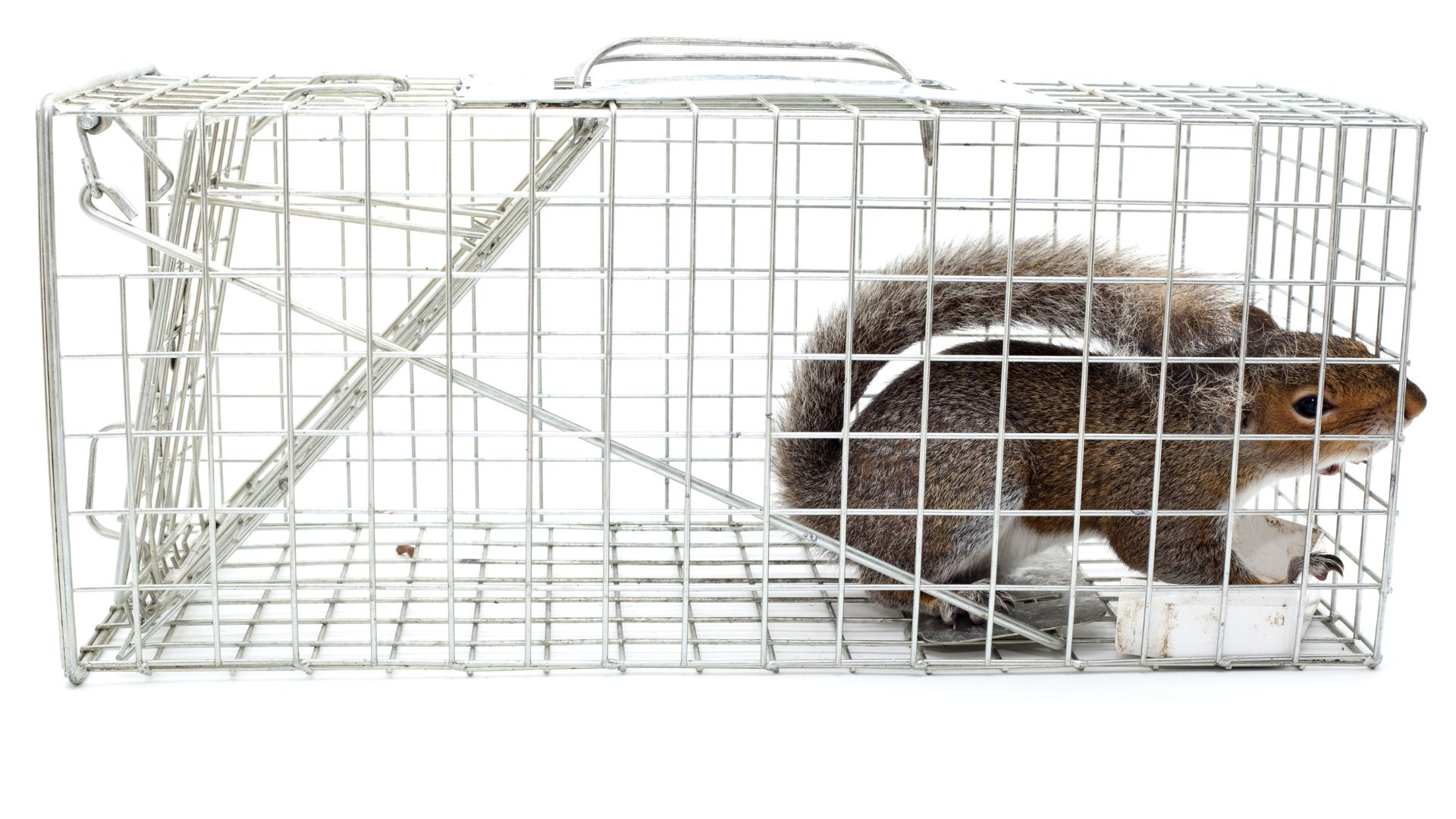
Squirrel Control: FAQs
What Can I Use to Get Rid of Squirrels in My Attic?
Nail several Single Door Squirrel Traps to a 24" piece of 2 x 4. Place the 2 x 4 in the gutter. This will bottom-weight the trap to keep it from falling.
How Do I Get Rid of Squirrels?
A consistent trapping program is best for squirrel control.
What Scents are Effective at Deterring Squirrels?
Squirrels have a strong sense of smell, which you can use to your advantage. Scents like peppermint oil, garlic, and vinegar are natural deterrents that can help keep squirrels away from your garden and home. Additionally, predator urine (such as from a fox or a coyote) can also be effective but should be used cautiously and ethically.
Get Rid of Squirrels with DIY Pest Control
Unlock the secret to a squirrel-free garden with our top-rated squirrel control products. Designed for efficacy and ease of use, these products offer a safe and humane solution to protect your outdoor spaces from squirrel damage. From natural deterrents to innovative traps, our carefully selected range ensures your garden remains undisturbed and thriving. Don't let squirrels dictate the health of your garden. Take action today and enjoy the peace of mind that comes with DIY Pest Control.
Shop Squirrel Control ProductsHow To Get Rid Of Squirrels
If you have an active squirrel infestation, learn how to trap and remove squirrels. Do squirrel poisons work?
There are several squirrel species, but tree squirrels are the most common nuisance for homeowners because they inhabit attics and garages and cause damage. They often gnaw on the exterior and interior walls, timbers, cables, and electric wiring. They have been known to short out electric power transformers due to their activities around power lines.
Squirrels are typically discovered because they make a lot of noise in the area they inhabit. The gray squirrel is the most common structure-infesting squirrel species. Squirrels are abundant in the wild because their numbers far exceed the number of predators. The large population and decreasing natural habitat due to construction in many areas cause them to seek shelter in houses. The chilly months of fall and winter cause squirrels to seek the warmth that is found in attics.
How do I remove squirrels? What can I do to keep squirrels out of the attic or garages?
A consistent trapping program is best for squirrel control.
Is there a squirrel poison that works?
Unfortunately, there are not many poison baits on the market that are labeled for squirrel control. The one exception is Ditrac Ground Squirrel Bait. This Squirrel bait is labeled for the western states in the US only.
Squirrel Control Recommendations
- Removal of any diet source: birdseed, for example, because they attract the squirrels is the first business order.
- Use gutter guards:Using gutter guards and covering downspouts will reduce the number of squirrels entering through the rooftop and facia boards.
- Poison Baits:There are no poison baits on the market that squirrels will eat and die. The one exception is Ditrac Ground Squirrel Bait is only made to control the California Ground Squirrel (found in western states). Typical rodent control bait for mice and rat control will not work against other squirrels.
- Trapping:The live trapping method of trapping squirrels is the only way to remove unwanted squirrels. Catching a
squirrel is the only way to get rid of squirrels in your attic, once they have chewed holes. It is
important to seal up and repair all entry points after trapping the squirrels, so they no longer have
access.
- Locate the trap along the path of entry and places of known foraging activity.
- Go about 4-5 miles away to relocate the squirrels, or it will find its way back to your area.
- You may want to consider local ordinances for trapping squirrels, in that they differ. Sometimes, a professional trapper with a nuisance control license is needed to capture the squirrel and relocate it.
Key Takeaway
Live trapping, while labor intensive, is the only reliable method for removing squirrels once they are in the attic.
Recommended Squirrel Traps
Safeguard #50450 Single Trap - for all squirrel types; Red Squirrel, Flying Squirrel, and the larger Gray Squirrel. This trap also traps rats well.
Traps Squirrels (red and flying), rats, weasels, chipmunks, and similar sized animals. Single door rigid live trap. Automatic locking doors to provide an almost escape-proof catch every time.
- Measures 18"x5 x5" with 1/2" grid.
- Made in the USA.
- The closing mechanism is one of the best on the market.
Havahart #1077 Squirrel Cage - for the larger Gray squirrel types, but not the smaller squirrel types.
The 1-inch grid would make this trap less preferable for trapping rats or the smaller squirrels.
- Single Door Spring Loaded
- 17" x 7" x 7" has a 1" grid.
How to prevent squirrel entry to buildings
- Trim tree branches that may overhang the roofline.
- Remove firewood stacked against the building.
- If there are cracks in the foundational wall, repair them.
- Seal entry points
Trapping Tips
- Always use work gloves when handling the traps with a squirrel inside.
- Some trappers like to use a technique called "pre-baiting" to gain the squirrel's confidence. Leave the trap out, wired open (so it won't shut) with the bait so that they can get used to the object in their environment. However, most of the time, this technique is not needed to trap squirrels successfully.
- Place traps where you hear or see the activity. Using a Rat/Squirrel lure(walnut/nut oil-based) on a cracker or piece of fruit behind the trip pan is very helpful as a lure. You may also try peanut butter. Next, use sunflower seeds on top of that and trail a line of sunflower seeds out the trap's front door so that there are "free" seeds a couple of feet in front of the trap. This method will help overcome any anxiety the squirrels may have about entering the trap.
Trapping Gray Squirrels-Use 1 inch or 1/2 Grid Traps
For trapping gray squirrels, place their traps along their pathways or entry points. Place live traps along the roof, at the base of a tree, or the base of the building they are entering.
Trapping Flying Squirrels-Use 1/2 Grid Traps
Flying squirrels would need to be trapped inside the attic areas because they glide into the attics. Look for their areas of activity, such as droppings, when placing the traps. Also, look into insulated areas that they use for nesting to place traps.
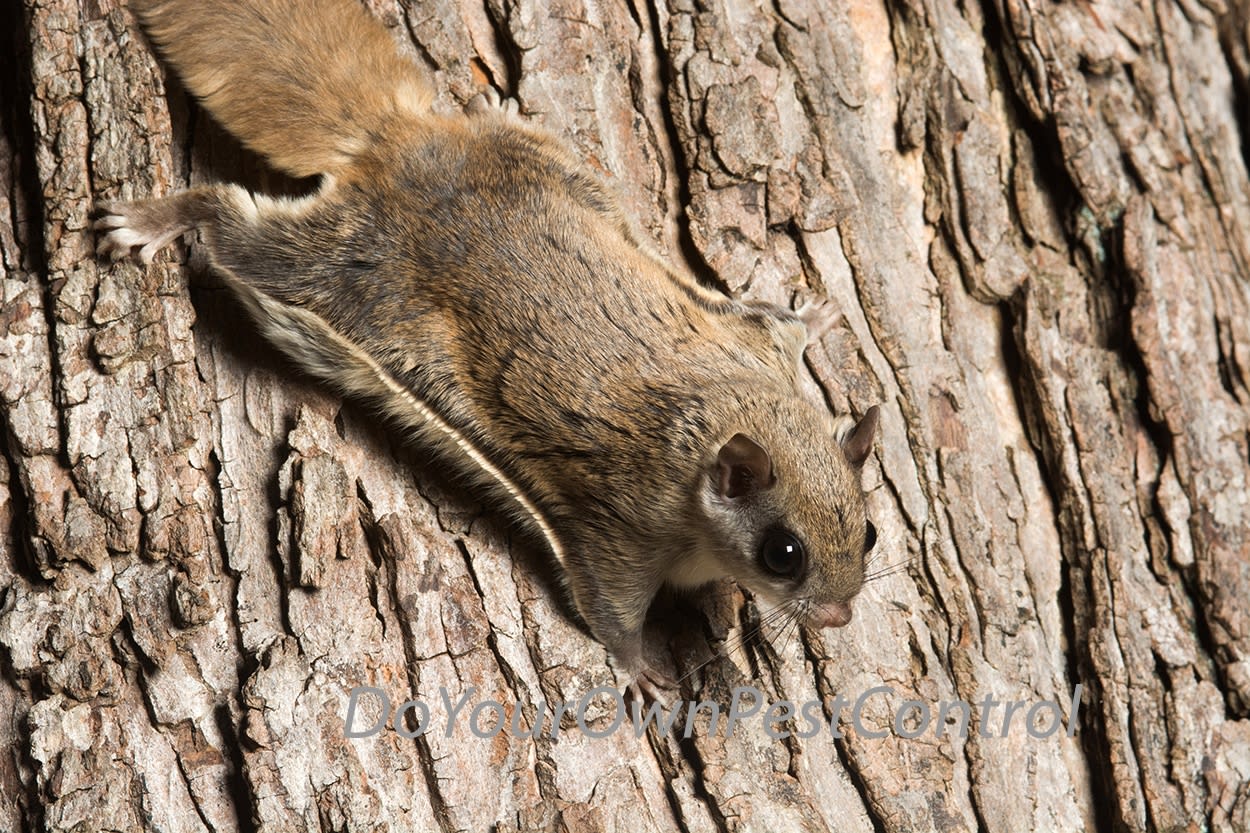
Flying Squirrels
The typical habitat for the Flying Squirrel is inside tree cavities in hardwoods. Smaller than the gray squirrel, they enter the tiniest of cracks and holes. The flying squirrels are about 9 inches long, including a 3-4 inch tail, and weigh about 3 ounces as an adult. They have dense, soft brown fur, white belly.
The flying squirrels don't fly but glide into attics from trees. They glide using a thin skin that extends out from the sides of the body and connects the front and hind legs, as shown in the above picture. In "flying," the squirrels leap spread-eagled and use their outstretched gliding membranes for gliding and their bushy tails for guidance. Glides of 60 meters (almost 200 feet) or more have been recorded of the Flying Squirrels.
Flying squirrels are nocturnal with their major activity at night. They are known to make plenty of noise during the night. Can be commonly heard, making a great deal of noise at night between sunset and sunrise. They may be heard landing on the roof or the sides of the house.
How Flying Squirrels Enter Buildings
Flying Squirrels can enter the attics through the eaves and soffits thru small cracks. These squirrels may quickly enter the space between the rooftop and facia board, chewing the area for a wider entry point.
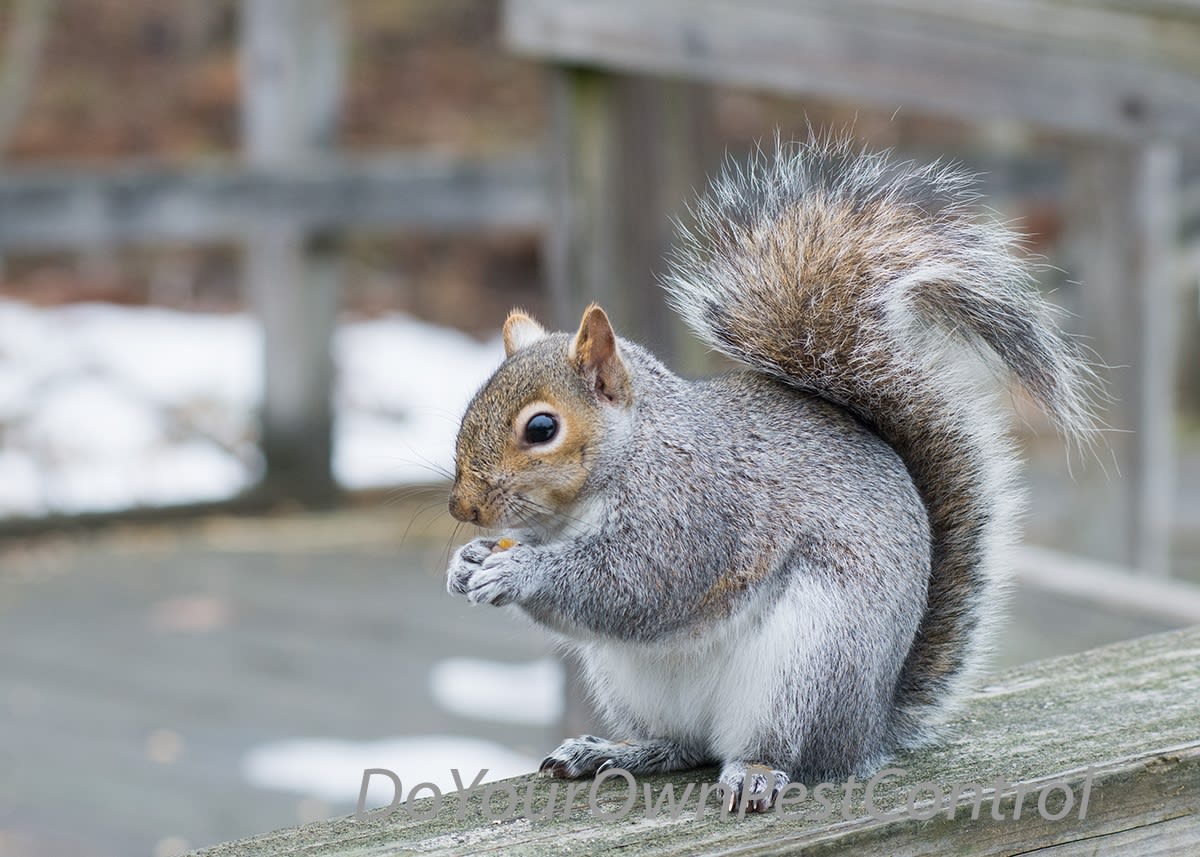
Gray Squirrels
Gray Squirrels are about 18 inches long, including their 9-inch tails. They are larger than the flying squirrels. Gray Squirrels weigh about 1-1.5 lbs. as an adult. Their coloration is usually gray, salt and pepper, but they can have tan hairs in the fur as well with white bellies. The winter coat is grey above with a white underside; the summer coat is shorter, sleeker, and brownish grey above.
Red squirrels have red/brown upper parts in summer but may show some grey on the back in winter, leading to some confusion. Red squirrels are smaller, lighter, have ear tufts, prominent in the winter coat, and brown on the legs and tail. Natural habitats for Gray Squirrels are wooded areas in tree cavities. They can be found near hardwoods like oaks and hickory trees. These squirrels will construct feeding shelters out of leaves.
More Gray Squirrel Features
- Generally have two litters a year, 2-4 young per litter. They usually breed in midwinter and late spring. Gestation is about 44 days.
- Diet consists of bird eggs, insects, berries, fruit, vegetables, nuts, and nestling birds. They like to hoard their food.
- Gray squirrels are active during the day, expecting to hear them during the daytime.
- Can inhabit the attic areas as well as crawl spaces. They like to enter the attic areas from your gutters and nearby trees and bushes. Installing gutter guards or downspouts with the screen may prevent them from climbing up to the roof through a downspout.
Squirrel Identification
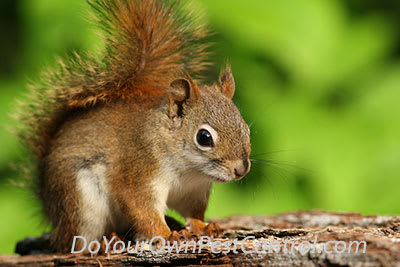
Red Squirrels
The American red squirrel is smaller than the flying or gray squirrel. It has a deep red color with a whitish underbelly and a distinctive white ring around its eyes. Their tails are not as bushy as other tree squirrels, and the color varies from red-brown to yellow-gray. They measure about 6 inches with a tail length of about 3-6 inches. Sometimes Red squirrels and Gray squirrels can look similar, even with their color variations. Red squirrels have ear tufts, while gray squirrels do not have ear tufts.
The Red squirrel has a notable screech, chirp, or growl; they are very vocal. These squirrels range across the USA and Canada, from the Rocky to the Appalachian mountains and from Arizona to Georgia. They are active during the day and feed on nuts, seeds, and conifer cones and feed on fruits, bird eggs, and nestling birds. They will defend their territories more so than other squirrels. They do not hibernate but will seek shelter during adverse weather conditions. Just before winter, they hoard food in nests, burrows, and tree cavities. They mate during the spring months and fall months.
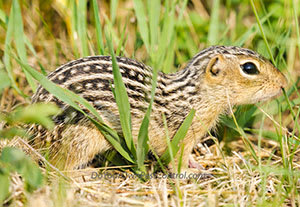
Thirteen-Lined Ground Squirrels (Striped gophers)
The thirteen-lined squirrel is another common pest found around lawns and foundations. They prefer grassy areas and hibernate during the winter months. They can damage newly planted seeds and pull up wheat, oats, and barley. They eat mice and insects. They make burrows but are poor climbers. They are commonly distributed among the midwest, from northern Texas to parts of Canada.
Prevent Squirrels: Exclusion and Relocation of Squirrels
After trapping and relocating the squirrels, you can seal the openings with 1/4" mesh hardware cloth or metal flashing. Look for all possible entry points. If you are not handy with tools, many nuisance wildlife control companies will seal entry points with a year's guarantee for a fee.
Squirrel Exclusion Products
There are several exclusion products that we recommend. Use a copper mesh wool or Xcluder Fill Fabric to stuff into holes and bigger openings. For smaller openings, use Foams in an aerosol form such as Pur Black NF Foam. It fills and seals voids.
Squirrel Repellents
Using Bobbex-R Animal Repellent repels Squirrels and other small animals (chipmunks, groundhogs, and voles). It repels them by taste and smell aversion. It is made of natural ingredients and benefits plants as well. It comes in a ready-to-use formula and concentrated formula.
Squirrel Control-FAQ's
You can cover the trap with insulation or leaves. You should be able to hear the babies. If so, they will have to be removed by hand. Anytime is fine to go in, but approach the babies with caution. Mom will defend them.
There is only one problem with such a device. When locked out of their house, squirrels will almost always chew open a new door. I recommend a live cage trap to remove them to a faraway place and seal entry points to combat this. When the entry points are sealed, new squirrels will not have an incentive to get inside.
Nail several Single Door Traps to a 24" piece of 2 x 4. Place the 2 x 4 in the gutter. This will bottom weight the trap to keep it from falling.
Written by our resident pest control expert Ken Martin.




